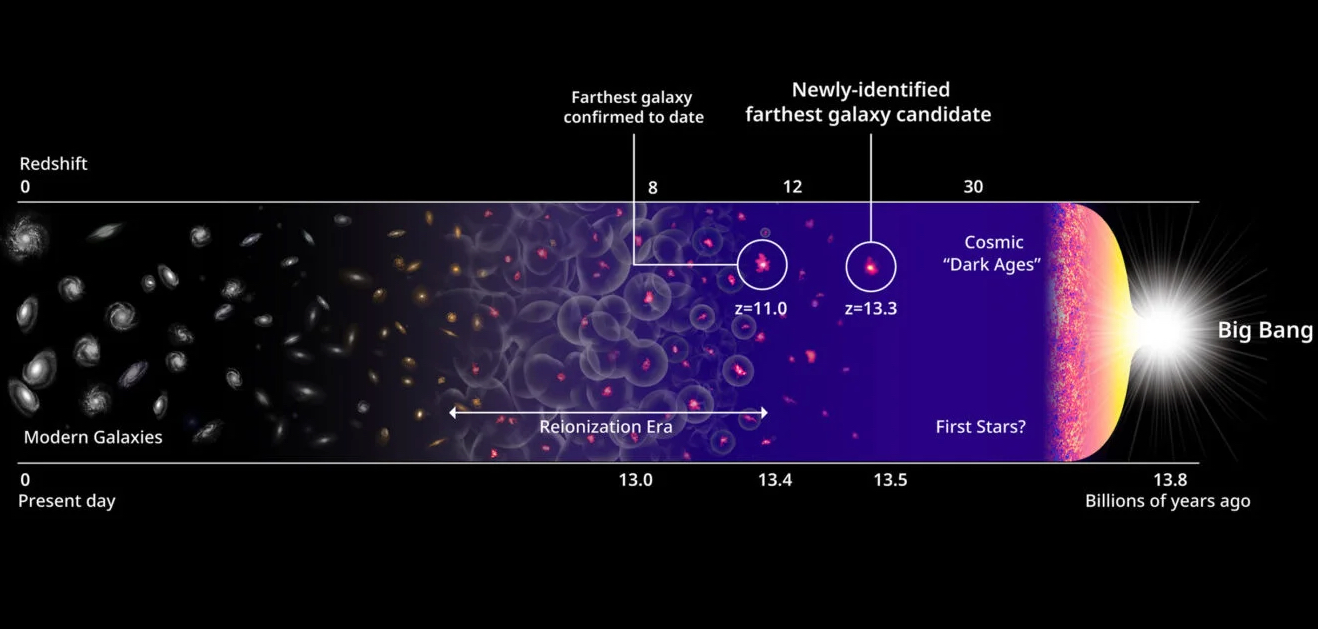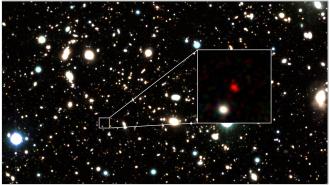An international team of astronomers, including scientists from Harvard University, has discovered what it believes is the farthest galaxy from Earth — and it likely contains either a never-before-seen type of star or a black hole 100 million times more massive than our sun.
Into the past: Light travels fast — 5.88 trillion miles per year — but because the universe is so large, it can still take a long time for the light from distant objects to reach our telescopes.
The galaxy lets us see back in time to just 300 millions years after the Big Bang, when the universe was still a baby.
That means when we see a really distant object, we’re seeing the light that left it a really long time ago. It’s like a window into the past, and the farther we look, the deeper into the past we can see.
The newly discovered galaxy, called HD1, is 13.5 billion light-years away, which is about 100 million light-years farther than any other galaxy yet seen. That distance means it’s showing astronomers what a galaxy looked like just 300 millions years after the Big Bang, when the universe was still a baby.
Finding the farthest galaxy: Light is a wave, and when an object is really far away from us, the wavelengths of its light become stretched, due to the expansion of the universe. Longer waves are found near the red end of the light spectrum, so this is called “redshifting.”
By examining a distant object’s redshift, astronomers can determine how far it is from Earth.
“HD1’s red color matched the expected characteristics of a galaxy 13.5 billion light-years away surprisingly well, giving me a little bit of goosebumps when I found it,” said University of Tokyo astronomer Yuichi Harikane, who first spotted HD1 in telescope observations.
“Some energetic processes are occurring there or, better yet, did occur some billions of years ago.”
Fabio Pacucci
After Harikane’s discovery, an international team of astronomers used the ALMA telescope array in Chile to confirm that HD1 is indeed the farthest galaxy from Earth. They’ve now published two papers on it, one in the Astrophysical Journal and another in the Monthly Notices of the Royal Astronomical Society Letters.
What is it? Now that HD1 has been discovered, the next step is learning everything we can about it — but that’s not going to be easy, given how far away it is.
“It’s like guessing the nationality of a ship from the flag it flies, while being faraway ashore, with the vessel in the middle of a gale and dense fog,” said researcher Fabio Pacucci from the Harvard-Smithsonian Center for Astrophysics. “One can maybe see some colors and shapes of the flag, but not in their entirety.”
A major clue as to what’s going on in HD1 is its seeming surplus of ultraviolet light. According to Pacucci, it means “some energetic processes are occurring there or, better yet, did occur some billions of years ago.”

Special starmaker: One possible explanation for this UV light is that the super ancient galaxy is forming stars unlike any we’ve ever observed.
“The very first population of stars that formed in the universe were more massive, more luminous, and hotter than modern stars,” said Pacucci. “If we assume the stars produced in HD1 are these first, or Population III, stars, then its properties could be explained more easily.”
“Population III stars are capable of producing more UV light than normal stars, which could clarify the extreme ultraviolet luminosity of HD1,” he added.
“Once again, nature appears to be more imaginative than we are.”
Avi Loeb
Big black hole: Another possibility is that HD1 contains a supermassive black hole, and we’re seeing light from material being pulled into it. But black holes usually take time to grow, so for this one to get so big, so early in the history of the universe, would change our understanding of black holes.
“Forming a few hundred million years after the Big Bang, a black hole in HD1 must have grown out of a massive seed at an unprecedented rate,” said Avi Loeb, an astronomer at the Center for Astrophysics. “Once again, nature appears to be more imaginative than we are.”
Looking ahead: The astronomers plan to use the recently launched James Webb Space Telescope, when it’s finally online, to verify that HD1 is the farthest galaxy from Earth.
They’re also hopeful that observations from Webb will allow them to test their theories as to why the galaxy is so bright — or perhaps unveil a previously unexplored explanation.
We’d love to hear from you! If you have a comment about this article or if you have a tip for a future Freethink story, please email us at [email protected].




